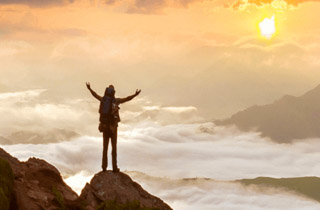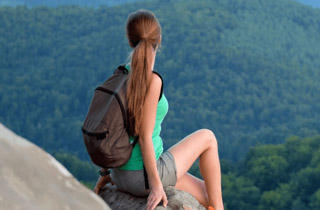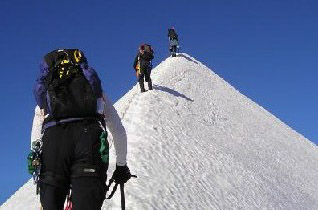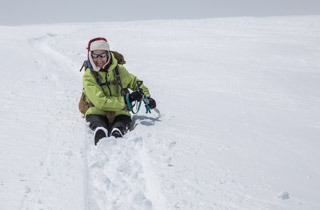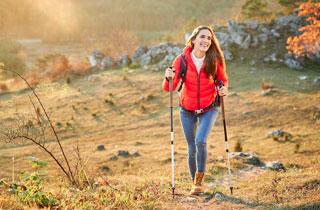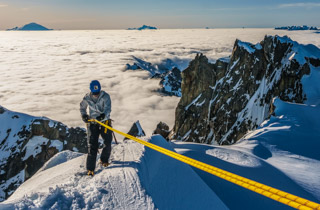Hiking Sport Specific Training
Hiking Sport Specific Training
To give you the edge over more generalized fitness programs, include hiking-specific tips that will help you to succeed with some of the following articles.
In order to build quadriceps strength and improve fitness without putting excessive stress on tentative or already painful knees, you might want to consider adding some backward travel to your training program. Try a few short bouts of walking backward up a gently inclined slope, on a slightly ramped treadmill, or jogging backward to test out how it feels.
Who Might Be a Candidate?
People who may benefit from backward-walking training include anyone who:
- Is undergoing post-surgical knee joint rehabilitation.
- Suffers from muscle strains of the hip, groin, hamstrings, or lower back
- Suffers from lower extremity injuries including sprained ankles, Achilles tears, or shin splints
- Has tried everything including ibuprofen, ice/heat treatments, complete time off from training, physical therapy, stretching, and more traditional strength training without sufficient results
- Is looking for a different stimulus or cross-training option
- Needs to be able to change directions rapidly and occasionally run backward in his or her sport (such as soccer, football, basketball, rugby, or lacrosse)
One of the elements we address throughout our book, The Outdoor Athlete (Human Kinetics: 2009) is the importance of including Back-to-Backs in programs designed for any multi-day adventure. In this article, we explore the basics of who, what, when, where, why, and how to do them for your sport.
Anyone who will be participating in multi-day trekking, backpacking, mountaineering, or climbing adventures with at least two consecutive days of pack carrying during their trip should include several back-to-backs in their training. This would also include anyone who wants to do several single-day hikes with a pack heavier than 10 pounds on successive days from a single launch point.
Not only does this prepare the body physiologically, but it also helps you be psychologically and mentally prepared to carry a pack on successive days without having to rest. Without practicing this basic overnight travel skill, you might find it shocking when you have to do it on a trip. Prepare now, enjoy later.
If you have gone on any steep hikes, you probably have already noticed that ascending with trekking poles helps set up a natural pace or rhythm while descending with trekking poles helps you spare your knees on the descent to some degree. Are there any other benefits or disadvantages to using poles?
An Austrian Study
In “Comparison of Knee Joint Forces During Downhill Walking With and Without Hiking Poles,” Roithner and others showed that the use of trekking or ski poles caused reductions of external and internal loads on the knee joint by up to 20%. This means that if you have weak knees and wish to protect them over the long term, having moderate pole support for the descents can save the knees and help prevent severe muscle soreness in the quadriceps.
Andriacchi and Mikosz (in “Muskuloskeletal Dynamics, Locomotion and Clinical Applications,” 1991) observed four times higher knee joint moments during descending stairs compared to walking on flat ground. If you have trouble walking downstairs or going down hills in the city, you will probably have even more difficulty on uneven terrain in the mountains, where steps can be steeper, more uneven, and unpredictable, and occur over longer periods.
Early season is a great time to start ramping up your pack weight on conditioning hikes if you are getting prepared to do a summer climb of Mt. Rainier, a trip to the Grand Canyon, a trek in Nepal, or whatever your ultimate backpacking destination might be. However, it might not always be so obvious what is the best way to pack your backpack.
Should you use metal weights? Books? Water jugs? Or climbing gear? What items should go where when packing for an actual trip? Here we include a few lower back and shoulder-sparing tips for training with your pack as well as preparing for your climb, trek, or backpacking trip.
In the Mountaineers, a volunteer-run organization based in Seattle, you can earn badges for “peak bagging.” This spring a woman wrote a piece for the Mountaineers Magazine on “lake bagging.” It made sense to supplement her piece with a training article on preparing for a summer of lake bagging.
I love visiting alpine lakes in any season. Last summer, I waded in Olallie Lake’s frigid waters, and in the winter I got to enjoy a snowy walk across its frozen surface with my daughter. Alpine lakes offer a refreshing respite during steamy summer adventures, but they can be a trek to reach. Here are some tips and tricks on how to prepare for any summer adventure that might include lake bagging so you can take the plunge with ease.

